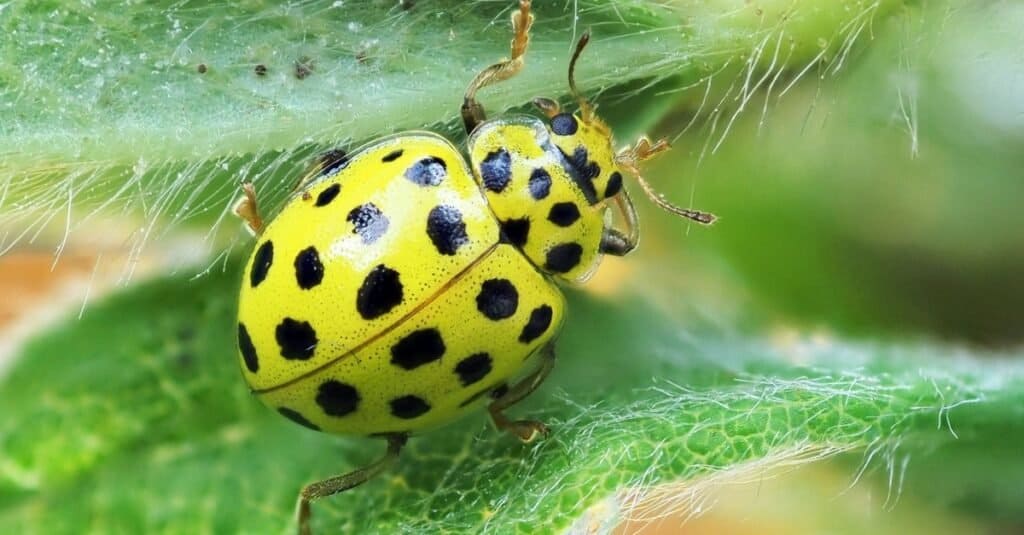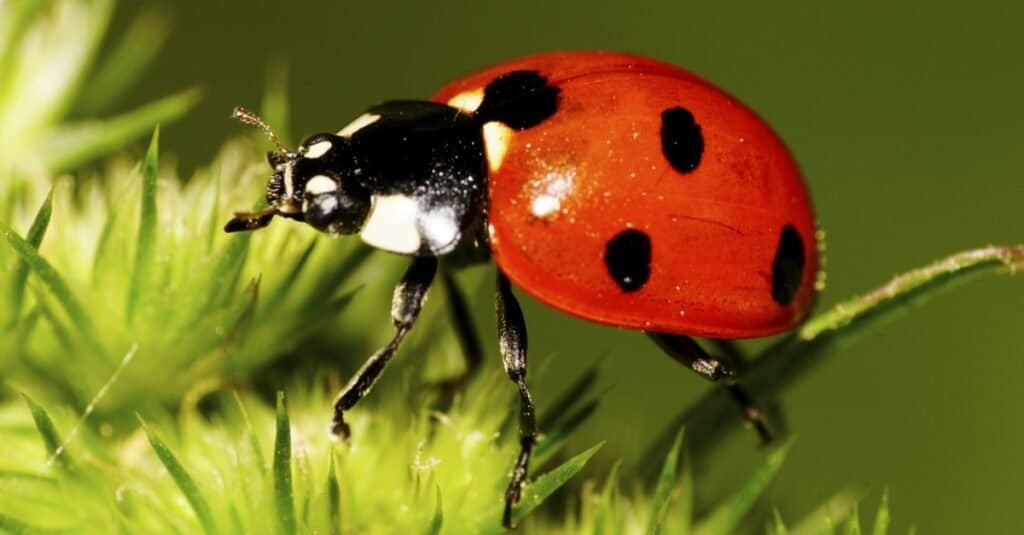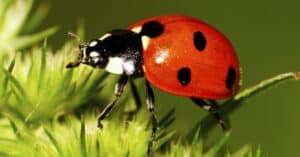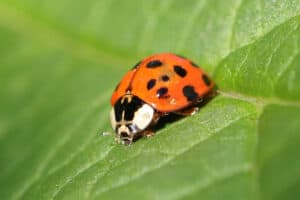Ladybugs are undoubtedly one of the most beautiful insects on the planet. They sport a bright, shiny dotted red color that is undeniably fascinating to look at. Also known as the ladybird beetle, its name fits its appearance perfectly. But underneath its colorful facade, did you know that the ladybug contains toxic fluids that help them deter predators? Predators who try to eat ladybugs can sometimes get sick from their toxic fluids. But, are ladybugs poisonous to their predators? Are ladybugs poisonous or venomous to people? If you eat a ladybug will you get sick? If a ladybug bites you will you get sick?
Do Ladybugs Bite?

Ladybugs usually bite to defend themselves.
©L-N/Shutterstock.com
Ladybugs do not sting, but they can bite. However, biting happens very rarely and usually just for self-defense. Ladybugs are so tiny, so they can’t cause any serious damage or injury whenever they bite humans. Their bite feels more like pressure than an actual puncture. Yet, some people may still develop allergic reactions to a ladybug’s toxins. Apart from biting, ladybugs can also “pinch” using their limbs. Their toxins are delivered from the joints in their legs when threatened. They can also give off a foul odor to dissuade predators. This foul-smelling liquid is the ladybug’s blood.
The ladybird beetle is one of the many types of beetles that have many benefits in different ecosystems. Yet, despite their beautiful and colorful facade, ladybugs can still be a nuisance to many households. Ladybird beetles can infest homes, and they can bite people too. Although their bite wouldn’t be a concern because you will barely feel anything, their toxic fluids can sometimes trigger some allergic reactions in people. When they bite, ladybugs leave a bite mark that can develop into red bumps or splotches in the skin due to allergic reactions.
A 2004 study discovered that around 26% of ladybird beetles would bite humans when enclosed in an environment. An entomologist put 641 ladybugs inside 11 various canisters in the research and observed how much of the ladybugs would bite him. The study deduced that ladybugs are more inclined to bite exposed areas without hair. Since there were no other trees, plants, or food sources inside the canisters, the study suggests that the ladybugs might have mistaken the human skin for food. Nonetheless, ladybug bites are generally harmless.
Are Ladybugs Dangerous to Humans?

Though ladybugs are generally not dangerous to humans, allergic people may experience symptoms.
© Sergey/Shutterstock.com
All types of ladybugs can bite you or pinch you with their legs, secreting toxic fluids as they do so. However, these bites are usually mildly painful and not life-threatening. Ladybugs are not dangerous to humans, but apart from the risk of biting and toxins, allergic people may experience some symptoms that most people do not typically have after a ladybug bite.
The ladybug secretions possess proteins that can trigger swelling of lips and airways or angioedema. People allergic to ladybugs can react to this protein and may trigger reactions. The proteins found in ladybugs are also present in German cockroaches, which are notorious for the allergic reactions they can cause.
Some ladybug species, such as the orange ladybug, are more likely to bite. When they feel threatened above your skin, ladybugs will secrete a pungent bloody fluid on you, which means they don’t feel comfortable or see you as a threat. This can lead them to bite, but since they are not bloodsuckers, the only thing you will be risking yourself with is the bite mark or red bump. Since ladybugs do not have enough force to break deeply through the skin, you have nothing to worry about their bites.
Are Ladybugs Poisonous?

If eaten, ladybugs can be poisonous to predators and other animals.
©Milton Buzon/Shutterstock.com
Are ladybugs poisonous? Ladybugs are not poisonous or harmful to humans, but they can be poisonous to predators and other animals when eaten.
Unlike most bugs, ladybugs do not carry diseases from one person to another because they do not suck blood and do not often land on human skin. Ladybugs can bite when threatened, and they are also known to secrete toxic fluids. Yet, this fluid is not poisonous to humans. However, the ladybug toxins can be harmful to other insects and small lizards or birds. They use their toxin-secreting limbs to ward off predators, which can have serious, detrimental effects.
Some ladybugs can be poisonous to other animals when eaten as well. The different colors and spots on their back are part of their defense system. Most ladybugs sport various colors which may mean their toxins are stronger and make predators very sick. Researchers suggest that the more colorful the ladybug is, the more toxic they are to animals and predators. Black-tinted ladybugs, for instance, are known to be the most toxic ladybugs and can trigger allergies in people. Orange ladybugs also contain more toxins in their bodies, making them the most allergenic. Brown ladybugs are the least toxic species.
Are Ladybugs Poisonous to Dogs?
While humans seem to endure the ladybug toxins, pet dogs might not. As curious as they are, dogs can often poke at ladybugs and sometimes eat them. However, once ladybugs are crushed inside the dog’s mouth, they secrete a toxic fluid that can cause some internal damage to the dog. Reports of previous incidents say that the damage left by ladybugs on dogs is similar to chemical burns. Dogs can also experience a burning feeling down their gastrointestinal tract as they try to swallow the toxic ladybug.
So, are ladybugs poisonous? While ladybugs can propagate into annoying numbers inside your home, ladybugs are certainly not poisonous for you. But they can be harmful to some of your pets at home. It may not always happen, but dogs who have just eaten a toxic ladybug may experience some behavioral changes, drowsiness, drooling, vomiting, or constipation.
Ladybugs often infest homes during warmer seasons as they hunt smaller insects found inside households. Planting lavenders and installing screens on your door and windows can help prevent ladybug infestation and keep your pets safe.
What Smells Attract Ladybugs?

Ladybugs are attracted to certain plant scents and having them in your garden may entice them to move it.
©Oakland Images/Shutterstock.com
Ladybugs are considered extremely beneficial to gardens. They are predators that have an incredible appetite, specifically for aphids and are known to eat around 5,000 of them throughout their life. They also can help rid your garden of other pesky insects like insect eggs, leafhoppers, mealybugs, mites, and even ants. If you would like to attract more ladybugs to your garden, there are certain scents you should have around.
Some of the scents that ladybugs enjoy come from certain plants and spices like angelica, caraway, cilantro, dill, fennel, geraniums, and cosmos. If you would like to attract them to your yard, you can simply plant these in our garden.
The photo featured at the top of this post is © iStock.com/Henrik_L
Thank you for reading! Have some feedback for us? Contact the AZ Animals editorial team.






